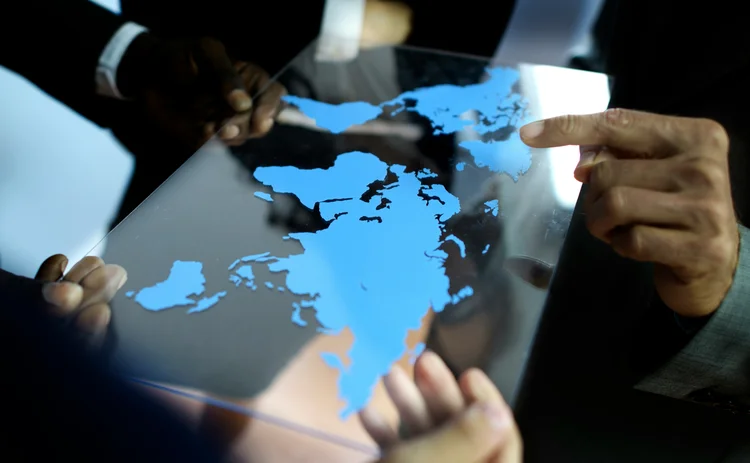Foreign policy impact on future FX reserves composition
Restrictive covenants in global financial safety net system drive fragmentation, while CBDCs and digital petroyuan may alter FX reserve investments

“Global economic ties are changing in ways we have not seen since the end of the Cold War,” said Gita Gopinath, first deputy managing director of the International Monetary Fund (IMF), in May 2024.
In this decisive year of elections, voters’ perceptions of the world’s competing economic superpowers are divided. Among the 147 countries to which China has committed $4 trillion as part of the Belt and Road Initiative, almost two-thirds hold a positive view of China, versus just one-quarter in non-participating countries, according to researchers at the University of Cambridge. They observed that Chinese funding for transportation and energy infrastructure comes “without the same conditionality required by western bilateral and multilateral aid”.
February 24, 2022 – the date Russia launched its invasion of Ukraine – was a turning point in recent history. The University of Cambridge authors, in their study published in October 2022, noted that the correlation between pro-China and pro-Russia attitudes is “higher than ever before”. These have become more strongly inversely correlated with views towards the US over the past decade.
Though businesses and governments do not reflect the views of all citizens, researchers at the Bank for International Settlements (BIS) found “geopolitically distant” countries are drifting apart economically, in a study published this year. Using voting patterns at the UN as a geopolitical index, the researchers found that, between 2017 and 2023, trade volumes grew 2.5% more slowly between countries that are further apart than between countries that are more aligned.
The US trade deficit with China had fallen to $185 billion in August 2024, after peaking at $418 billion in 2018 when the trade war started. The 2023 US Census Bureau survey shows that US imports from China have decreased since 2018 but its exports have increased. The US has had a trade deficit with China every year since at least 1985.
However, China’s loans do not come without conditions. Similar to how IMF conditionality was a deterrent to using the Chiang Mai Initiative – the bilateral currency swaps framework between Asian central banks, established after the regional crisis in 1997 – China’s new Silk Road loans come with stipulations that debt cannot be restructured by Paris Club creditor governments, fragmenting international financial infrastructure. Access to Chiang Mai – now the Chiang Mai Initiative Multilateralisation – was restricted to 20% of a country’s IMF quota without an IMF programme, and the Council on Foreign Relations reports have never been used. Though this was revised up to 40% in 2021, borrowing through US Federal Reserve swap lines established during the global financial crisis that began in 2007–08 had no such limits and did not require any sort of IMF programme.
Gopinath presented the world as being made up of three blocs: US-leaning, China-leaning and non-aligned countries. The Non-Aligned Movement, with 120 country members, was founded in 1961 against the backdrop of the Cold War, and played a role in decolonisation and the formation of new independent states. Gopinath and others found that, in the period after Russia’s invasion of Ukraine, trade and foreign direct investment between China-leaning and US-leaning blocs declined by approximately 12% and 20% more than flows within blocs, respectively. These patterns held even when the US or China were removed from IMF analysis.
“Countries are re-evaluating their trading partners based on economic and national security concerns. Foreign direct investment flows are also being redirected along geopolitical lines,” said Gopinath, with implications for foreign exchange reserves.
Antanas Mikšys, chief portfolio manager at the Bank of Lithuania, tells Central Banking: “Foreign policy plays an important role when engaging in portfolio management exercises.” It was a factor that “drove the Bank of Lithuania’s decision to cut its exposure in the China government bond market in 2022”.
Mikšys says the decision was made “in the context of Lithuania’s deteriorating relationship with China over several years, regarding its policies over Taiwan, human rights and, most recently, China’s stance with respect to the war in Ukraine”.
Mikšys points out that economic factors also played a “significant role” when considering allocations in renminbi. Hedging currency risk related to Chinese bond investments was becoming more expensive, “making potential expected returns on these investments less attractive”.
“[The] combination of multiple challenges in managing renminbi exposures ultimately led to the decision to sell the Bank of Lithuania’s CGB [Chinese government bond] holdings,” says Mikšys.
Aleš Michl, governor of the Czech National Bank (CNB), tells Central Banking the central bank also reduced its allocation to the renminbi, in part due to geopolitical risks. “Last year, we excluded the Chinese renminbi portfolio from the CNB reserves,” says Michl. “It was sold because of geopolitical risks perceived by the bank board and because the renminbi portfolio generated lower returns than most other portfolios.”
The CNB’s strategy is “independent of any political opinion”, Michl underscores. “We did not sell the portfolio for political reasons … if it is profitable, when adjusted for risk and liquidity, for the reserve management strategy, we will restore the portfolio again.”
Regarding the outlook for 2025 and beyond, Mikšys says that: “Divergence of US and Chinese foreign policy contributes to deglobalisation of the world economy, and that causes some trade frictions between businesses in these blocs.” In his view, this trend is here to stay and “is going to have a significant impact on the world’s economy”. Furthermore, officials at the central bank “think that foreign policy and geopolitical events may act as a catalyst to spark unexpected volatility in financial markets”.
In terms of reserve management, Mikšys says that the Bank of Lithuania is “regularly considering expanding its foreign reserves to diversify into other currencies, but we prefer to add hard currency exposure with little geopolitical risk”.
Gopinath’s sentiment that “some countries are re-evaluating their heavy reliance on the dollar in their international transactions and reserve holdings” was also expressed by some Africa-based central bank reserve managers at the Central Banking Summer Meetings. They spoke of a “chilling effect” that seizing Russia’s FX reserves has had on trust in the US dollar.
In response to Central Banking’s Reserve Benchmarks 2024, a reserve manager in the Americas said: “The seizing of Russia’s FX reserves sets a troubling precedent that undermines the rule of law … such actions could erode global trust in the stability and reliability of the international financial system.”
Creon Butler, director of global economy and finance programme at Chatham House, wrote in May that “permanently confiscating $300 billion of Russian FX reserve assets”, which make up 2.5% of the global total, “would increase the risk perceived” by substantial holders of Russian assets, such as China, India and Saudi Arabia.
Two central banks – one each in Africa and Asia – indicated in the Reserve Benchmarks that they had increased their gold holdings directly because of sanctions on China and Russia. China itself has, since the escalation of the Ukraine-Russia conflict in 2022, reduced its dollar holdings by $250 billion, from over $1 trillion. Japan had overtaken China as the largest holder of US treasuries in November 2016, after China’s investment peaked at $1.3 trillion in October 2013. Now the UK holds nearly as many US Treasuries as China, having significantly increased its holdings since Brexit in 2016.
Nonetheless, the downward trend of dollar assets in global FX reserves remains gradual, falling from 58.9% in the first quarter of 2022 to 58.2% in Q2 2024, according to IMF Cofer data available at the time of writing. Global dollar FX reserves were around 64% in 2007, when the global financial crisis was unfolding. It is since the financial crisis that China has purchased around half of its 2,264-tonne stockpile of gold, and Russia 83% of its 2,335 tonnes. Notably, renminbi holdings had been steadily growing until Russia’s invasion of Ukraine but, in the same period, have fallen from 2.8% to 2.1% of global FX reserves. Meanwhile, global FX reserves holdings in the Australian dollar and the Canadian dollar this year both overtook the renminbi.
Renminbi internationalisation is still on the agenda. The People’s Bank of China’s (PBoC’s) 2023 Renminbi internationalization report stated that 29 out of 40 of the central bank’s bilateral local currency swap agreements are still active. But, despite its proliferation of lending, until the renminbi is freely convertible, its role in central bank reserves is likely to remain limited.
Meanwhile, alongside the blocs Gopinath identified, there are also those countries that that appear to wish to be allies to both China and the US. Saudi Arabia, the world’s largest crude oil exporter, is reportedly considering using the petroyuan – a form of the yuan intended for oil trading. The first crude oil transaction in this digital currency was settled in 2023, but the seller was not revealed. At the same time, Saudi Arabia is the US’s largest foreign military sales customer, with more than $100 billion in contracts open, and it has yet to ratify its Brics+ membership.
As well as restrictive covenants in loans offered by the IMF and China, international collaboration around central bank digital currencies (CBDCs) and interoperability in their design may come to play a significant role in the composition of foreign reserves.
Saudi Arabia joined the BIS’s cross-border CBDC mBridge project in June. Initiated by the Hong Kong Monetary Authority and the Bank of Thailand in 2019, the PBoC’s Digital Currency Institute and Central Bank of the United Arab Emirates (UAE) joined in 2021. The Digital Currency Institute of the PBoC became the technology subcommittee lead. The PBoC and Bank of Russia are both actively promoting their CBDCs – Russia, for geopolitical reasons after many of its institutions were expelled from Swift. An official at a multilateral lending organisation says: “If Russia can trade electronically, it does not have to go through the dollar.” Russian president Vladimir Putin at the Brics Summit this October spoke of advancing plans of a “Brics bridge”.
Earlier in 2020, the Saudi Central Bank and the Central Bank of the UAE completed a wholesale CBDC project called Project Aber. Because the Saudi riyal and UAE dirham are both pegged to the US dollar, the official, speaking on condition of anonymity, points out: “If you hold them, you have no risk” (as long as the pegs hold) and “you avoid the Fed system”. A week after the Brics Summit, BIS general manger Agustin Carstens said that the BIS is leaving mBridge. He denied that mBridge is the “Brics bridge”.
During the Brics Summit and IMF meetings, officials from the IMF, the Chiang Mai Initiative Multilateralisation and Brics Contingent Reserve Arrangement were among attendees of the Regional Financing Arrangements dialogue, held in Washington, DC, to discuss the future amid “elevated policy uncertainty”. Artificial intelligence and technology are transforming the global economy, but slower global growth than in the pre-Covid-19 pandemic decade is “marked by risks of geoeconomic fragmentation and the threat of climate change”. Recognising the system of international co-operation is “under strain”, attendees, according to an IMF press statement, reiterated their commitment to open dialogue to “share crisis experiences” and “support multilateralism”. The 10th such meeting will be held next year.
Only users who have a paid subscription or are part of a corporate subscription are able to print or copy content.
To access these options, along with all other subscription benefits, please contact info@centralbanking.com or view our subscription options here: http://subscriptions.centralbanking.com/subscribe
You are currently unable to print this content. Please contact info@centralbanking.com to find out more.
You are currently unable to copy this content. Please contact info@centralbanking.com to find out more.
Copyright Infopro Digital Limited. All rights reserved.
As outlined in our terms and conditions, https://www.infopro-digital.com/terms-and-conditions/subscriptions/ (point 2.4), printing is limited to a single copy.
If you would like to purchase additional rights please email info@centralbanking.com
Copyright Infopro Digital Limited. All rights reserved.
You may share this content using our article tools. As outlined in our terms and conditions, https://www.infopro-digital.com/terms-and-conditions/subscriptions/ (clause 2.4), an Authorised User may only make one copy of the materials for their own personal use. You must also comply with the restrictions in clause 2.5.
If you would like to purchase additional rights please email info@centralbanking.com








